All together: Sanat displays calligraphy, landscape, portrait and still life
Twenty artists, who were students of RM Studio, pay tribute to their teachers.
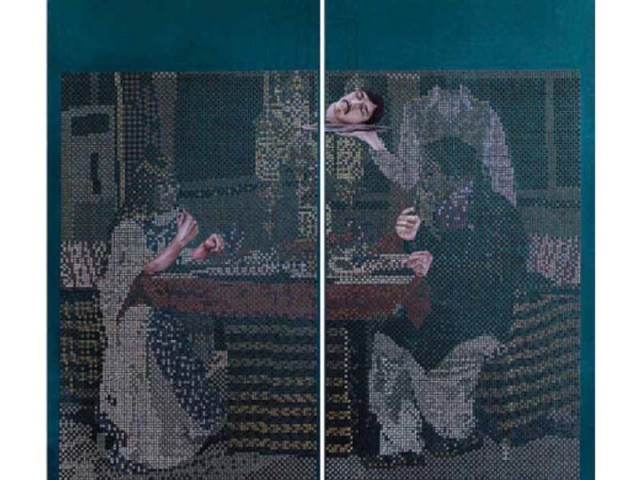
Abid Aslam
The Sanat Initiative is hosting its most extensive and long-awaited exhibition: Silsila.
Four genres of art — calligraphy, landscape, portrait and still life — seemed to be the focus of the show. Twenty artists associated with the RM Studio in Lahore came up with 25 masterpieces to exhibit at Silsila’s second instalment. They belonged to different batches that allowed exploration into the realms of traditional and contemporary art.
The works are a tribute to the teachers from the students of RM Studio. The show will continue till May 16. The artists include one from Islamabad, five from Karachi and 15 from Lahore.
Silsila is a collaborative project of Sanat Initiative and RM Studio. “Bringing in as many as 20 artists under one roof is not an easy task,” said gallery owner Abid Merchant. “But we were sure about what we were doing. I had a firm belief in this project, since the idea had been floating in my mind even before the inception of Sanat.”
He went on to describe how he and RM Studio owner RM Naeem sat together on April 19 last year and decided to come up with themes for a joint project. “On April 19 this year, we inaugurated our year-long hard work in the form of these pieces.”
The works
According to National College of Arts (NCA) graduate Sana Arjumand, the moon in her work, titled ‘Mystery of our Landscape is the Moon’, is a lover and its attraction is far greater than any other element on our landscape. Working with the lighter and darker sides of the moon, she used acrylic and embroidery on wasli. “The closest heavenly body to us is the moon, majestically taking over all other elements of landscape with a powerful glowing mist of love,” she said.
While acrylic, charcoal and other such mediums are the usual choice of artists, NCA graduate Faisal Asghar opted for the ballpoint pen. Using blue and black pens, he commented on how human survival depends on the health of the ecosystem in his work, titled ‘Another Housing Society’.
Mizna Baluch’s artwork is a powerful comment on the adverse side of our technological advancement. The title of her work is ‘So we fired! And six seconds before missile impacted, something small ran down the building. The screener told me, it was a dog. But I don’t think so. Was I seeing things? Ultimately I believe there was a child killed.’ It comprised four parts, each depicting an aerial view of drone attacks and still life.
Still life for many artists means mostly inanimate objects. For NCA graduate Amra Khan, dead goats are a symbol of still life. “They once lived,” she explained the title ‘A Very Still Life’. “Now stillness surrounds their lives.”
Using acrylic on canvas, RM Naeem has provided two sides of an image, leaving it up to the viewer how to understand it. “Every element and subject in this work has dual meaning,” said Merchant, talking about the work titled ‘Still + Life’. “For me this can be a triangle and for you it can be a pyramid.”
Ambiguity is a feature shared by NCA graduate Kiran Saleem but in a different way. Playing with dimensions, she created an effect that made her work look like a picture pasted on a wall, while in reality, it was a painting. “I started questioning what art is and what it is not,” said the artist, talking about her interest in reality and unreality. “My work is about the visual experience of looking at things that could be considered art.”
As far as reality and appearance are concerned, Muhammad Zeeshan had his own approach. His work, titled ‘In God We Trust’, looks like an American flag from a distance but a closer look shows that it is Islamic calligraphy in black and white. The words read ‘Ya Allah Khair, Ya Allah Madad’ and ‘Ya Allah Reham’. When seen in the context of the title that is also the American motto, this becomes a clever play of words combined with a clever play of art. “This work treads the thin boundary between found imagery and originality ascribed to any visual that exists,” explained Zeeshan, who specialises in miniature paintings.
Abid Aslam, who works with eyelets, has explored imagination in his diptych titled ‘Lover’s Dinner’. “Punching colourful eyelets into the surface of wasli, I attempt to capture the urban landscape of Lahore,” he explained his work. Aslam has used the medium in a marvellous way such that the breaking and coming together of colours become the most intriguing part of the work.
Published in The Express Tribune, May 3rd, 2015.

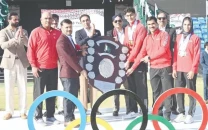
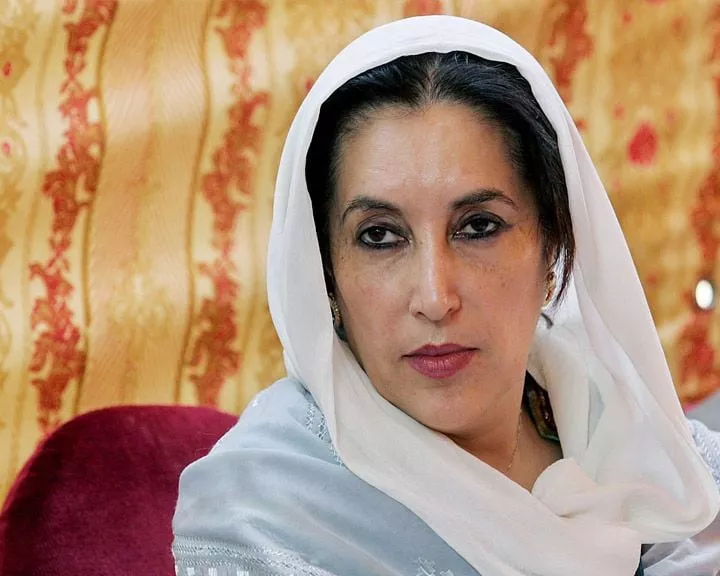
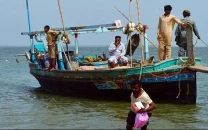


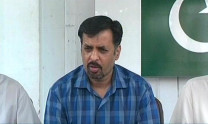












COMMENTS
Comments are moderated and generally will be posted if they are on-topic and not abusive.
For more information, please see our Comments FAQ